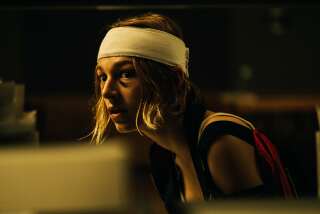MOVIE REVIEW : SOVIET’S ‘SCARECROW’ A STINGING, POWERFUL GEM
- Share via
To have become another nation’s “most popular film” isn’t necessarily a virtue, as audiences for “The Man From Snowy River” will be the first to remember. But “Scarecrow” (Los Feliz Theater), which was the Soviet Union’s biggest hit in 1986, is a beauty.
Made in 1983 and another of the films dislodged by glasnost from its place on a shelf, “Scarecrow” is all the more interesting as a success story since its theme is staunch personal integrity in the face of mass opposition.
Director Rolan Bykov, who began as an actor and has a fine moment here as a cadet band leader, is already well known for his films with child and teen-age actors. But even so, “Scarecrow” is extraordinary--haunting, stinging and powerful.
Bykov uses an ensemble of sixth-grade school kids as a choreographer would, moving them in flowing masses or jagged, dangerous spurts--picking out one, then another, easily differentiating them for us.
His film is done with a gorgeous, misty palette: outdoors where uniformed cadet bands oom-pah-pah among the falling leaves, inside in dark, old wooden houses, gingerbread around their shutters, the rooms crammed with bentwood furniture. And at the heart of the film is a luminous, steadily unfolding central performance by a 12-year-old, Christina Orbakaite, who grows from a naive child, pathetically anxious to be accepted, to a genuine heroine.
Orbakaite plays Lena, a reed-like, pale-blond newcomer to a small provincial school in one of the riverside towns that ring Moscow today. Her face has the sort of planes that Renaissance painters immortalized; her clear, direct gaze is pure and shattering. She could be Meryl Streep at the age of 12. Predictably, she believes she’s ugly.
Lena has come to this town with her granddad (Yury Nikulin), whose personal mission is to collect the ancestral paintings of that village, which dates back to the 15th Century. Mostly portraits--generals, landowners, Crimean war heroines, an amazing legacy--their gold frames a contrast to the half-logs of his walls, they crowd every room. (You could conceivably go to “Scarecrow” for its art direction and cinematography alone.)
But as she blurts out in a flashback, Lena is so anxious to have her classmates like her that she sacrifices her pride in her grandfather and joins the others in laughing at his ragged clothes, his passion for dusty old pictures. It’s a hateful act, and she hates herself at the same time she does it. And it doesn’t keep the kids from calling her chuchelo (scarecrow) anyway (weirdo is probably closer to the vernacular).
For a while it seems that Lena has a protector in Dima, the handsome class leader she idolizes. He can certainly be brave, standing up to an adult who seizes stray dogs to sell them to the tallow works. Then, in the film’s crucial action, Dima turns moral coward. Blindly loyal, Lena makes every excuse she can for him, then finally shoulders the blame herself. Since the outcome denies the kids a long-worked-for trip to Moscow, it makes Lena the class pariah.
The screenwriters (director Bykov, Vladimir Zheleznikov) have the cruel dynamics of a group of kids this age down exactly. And when you add the surrounding political climate, where this group of 12-year-olds have teethed on phrases such as “official reprimands” and whose weapon of ostracizing extends to burning in effigy, you have a chilling group portrait and a rare piece of social criticism.
You also have a fascinating glimpse straight to the heart of another culture: sixth-grade Soviet kids with their red neckerchiefs and their adidas gym bags, their rhetoric and their rock ‘n’ roll. “Scarecrow” (Times-rated Family) would seem to be one of those films that teaches as effortlessly as it entertains.
More to Read
Only good movies
Get the Indie Focus newsletter, Mark Olsen's weekly guide to the world of cinema.
You may occasionally receive promotional content from the Los Angeles Times.










